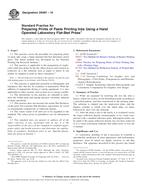We need your consent to use the individual data so that you can see information about your interests, among other things. Click "OK" to give your consent.
ASTM D6487-10
Standard Practice for Preparing Prints of Paste Printing Inks Using a Hand Operated Laboratory Flat-Bed Press
STANDARD published on 15.7.2010
The information about the standard:
Designation standards: ASTM D6487-10
Note: WITHDRAWN
Publication date standards: 15.7.2010
SKU: NS-35345
The number of pages: 5
Approximate weight : 15 g (0.03 lbs)
Country: American technical standard
Category: Technical standards ASTM
The category - similar standards:
Annotation of standard text ASTM D6487-10 :
Keywords:
dry offset proofing, letterset proofing, paste printing inks, printing inks, proofing of inks, Color proofing press, Offset color proofing press, Paste printing inks, Printing inks/vehicles, ICS Number Code 87.080 (Inks. Printing inks)
Additional information
| Significance and Use | ||||||||
|
Laboratory proofing of ink is necessary to establish a reproducible prediction of print appearance and performance properties, most of which are highly sensitive to ink film thickness. The apparatus described in this practice has found wide use for routine control proofing because it provides an economical method for producing reasonably large prints at film thicknesses comparable to those obtained on production presses. This practice does not duplicate the dynamics of a high speed press, nevertheless, it is useful for quality control and for specification acceptance between the producer and the user where there is an agreed upon specification for reflection density or standard reference print. |
||||||||
| 1. Scope | ||||||||
|
1.1 This practice covers the procedure for preparing prints of paste inks using a hand operated flat-bed laboratory proof press. The initial method was developed by the National Printing Ink Research Institute. 1.3 This practice is applicable primarily to lithographic and letterpress inks that dry by oxidation or penetration. With the addition of appropriate drying or curing equipment, it is also applicable to other systems such as heat-set or energy-curable. 1.4 The instructions in this practice are intended to minimize the within-print and among-operator variability inherent in hand operations. 1.5 This practice does not measure the actual film thickness on the print, but evaluates film thickness equivalence by visual or instrumental comparisons of reflection density. 1.6 The values stated in SI units are to be regarded as the standard. The values given in parentheses are for information only. 1.7 This standard does not purport to address all of the safety concerns, if any, associated with its use. It is the responsibility of the users of this standard to establish appropriate safety and health practices and determine the applicability of regulatory limitations prior to use. Specific precautions are given in Section 7. |
||||||||
| 2. Referenced Documents | ||||||||
|
Similar standards:
Historical
1.6.2013
Historical
1.6.2010
Historical
1.6.2012
Historical
1.6.2011
Historical
1.6.2012
Historical
1.1.2014
We recommend:
Updating of laws
Do you want to be sure about the validity of used regulations?
We offer you a solution so that you could use valid and updated legislative regulations.
Would you like to get more information? Look at this page.



 ASTM D6989-03(2013)..
ASTM D6989-03(2013).. ASTM D7188-05(2010)..
ASTM D7188-05(2010).. ASTM D7189-12
ASTM D7189-12 ASTM D7244-06a(2011)..
ASTM D7244-06a(2011).. ASTM D7271-06(2012)..
ASTM D7271-06(2012).. ASTM D7514-14
ASTM D7514-14
 Cookies
Cookies
